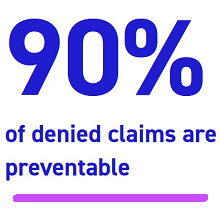Each appeal letter must include administrative information regarding the patient’s encounter with a healthcare provider. Administrative information provides identification that ensures payer and provider are reviewing the same patient encounter. Administrative information might include patient name, date of birth, insurance identification numbers, and dates of service, among other things. Set up administrative information placeholders in the template, typically near the top of the letter before the narrative, as part of the introduction of the patient. Include all information that is required by any payer to ensure the template works for all payers. For example, some payers may require the medical record number and some payers not.
Provide administrative information in table format for ease of reading. Here’s an example:
| Beneficiary Name |
| Member ID or MBI Number |
| Date of Birth |
| Claim Dates of Service |
| Medical Record Number |
Introducing the Patient
Administrative or technical denials typically don’t require a clinical picture of the patient’s medical condition or medical care to be submitted to the payer to secure appropriate payment. However, clinical and coding denials almost always require clinical medical record documentation to support payment. Medical necessity denials, in particular, require clinical information to be included in the appeal.
Appeals for medical necessity, coding, and clinical validation denials include information about the patient’s encounter with the provider (the hospital, the physician, the durable medical equipment supplier, etc.). Thus, an appeal includes references to the patient, the patient’s past medical problems, the patient’s current medical condition, the patient’s social environment, and a whole host of other information that impacts the patient’s health. Persuading the reader that particular medical services provided were or are reasonable and necessary for any given individual starts with understanding the specific situation of the individual. Including clinical information specific to the patient is part of setting the stage so that the reader sees a holistic picture of the patient.
When developing templates for appeals, create clear placeholders in the document for the writer to insert the clinical information required for the particular denial issue. For medical necessity or level of care denials, required clinical information might include age and gender, medical history, current medications, allergies, pertinent family history, living conditions when relevant, and social or environmental factors. For coding or clinical validation appeals, required clinical information might include only age and gender. Additional clinical information needed to support the coding or clinical validation appeal argument will vary based on the specific denial reason.
Placeholders for clinical information can appear in the template in table or narrative form. A table form might look like this:
| Beneficiary Name |
| Member ID or MBI Number |
| Claim Dates of Service |
| Reason(s) for Denial |
| Principal Diagnosis |
| Comorbidities/Complicating Factors |
| Procedures |
| Social Factors |
A narrative form might look like this, where the words in italic or within brackets are replaced by the writer to represent the specific patient’s situation:
Patient was a [blind, wheelchair-bound, developmentally delayed, brain-injured,] ___ year-old [disabled/widowed] [lady/gentleman] who lived [alone, in a nursing home, in an assisted living facility,] with a medical history as outlined above and a family history of _____ [list pertinent family history, if applicable]. Of note, patient routinely took [# of medications & any allergies with allergic response if severe].
Coding and clinical validation appeals may require a smaller amount of clinical information than medical necessity denials since their focus is on coding and clinical support of particular diagnoses, procedures, and coding regulations. Introductory patient information might include age and gender only. The remainder of the template contains placeholders specific to the needs of a coding or clinical validation appeal argument.




